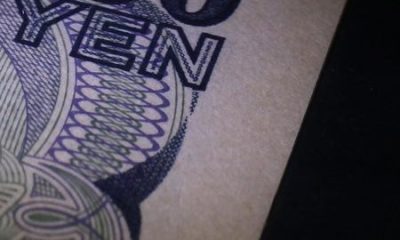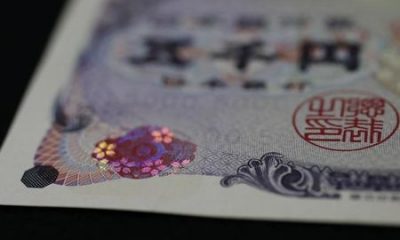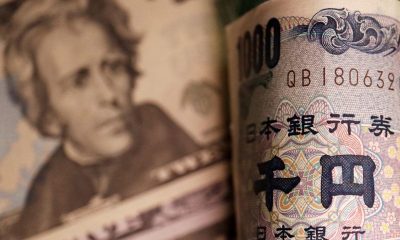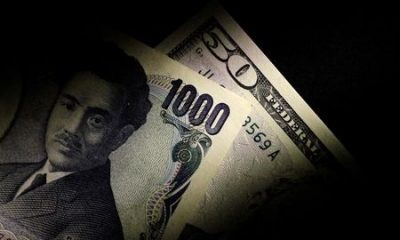Economy
Central banks’ rate hike push slips into August lull, EM diverging

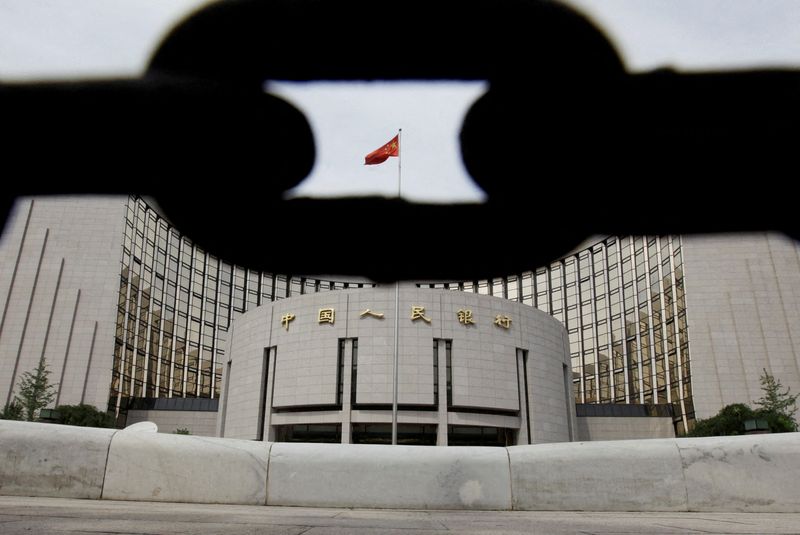
© Reuters. FILE PHOTO: The headquarters of the People’s Bank of China, the central bank, is pictured behind an iron chain in Beijing August 30, 2010. REUTERS/Jason Lee//File Photo
By Karin Strohecker and Vincent Flasseur
LONDON (Reuters) – Central banks across major developed and emerging economies took a breather in August with the pace and scale of interest rate hikes shifting another gear lower as diverging growth outlooks and inflation risks muddied the outlook ahead.
August – often a more quiet month for monetary policy decisions – saw only four of the central banks overseeing the 10 most heavily traded currencies hold rate setting meetings. Two of them – Norway and United Kingdom – delivered a total of 50 basis points of rate hikes in the lowest such tally since January. Australia and New Zealand kept their benchmarks unchanged, Reuters data showed.
The moves compare to three hikes across six meetings in July, and takes the total 2023 year-to-date tally for G10 central banks to a total of 1,075 bps across 33 hikes.
But the outlook ahead was murky, with surprisingly resilient U.S. data contrasting with disappointing numbers from China and much of Europe and markets searching for clues when major central banks could embark on easing rates.
“This downbeat growth story does have an upbeat consequence; inflationary pressure should ease further,” said ING’s global head of macroeconomics Carsten Brzeski. He added that while this was likely not enough to bring inflation back to target for many central banks, it should be low enough to see the peak in policy rate hikes.
“Central bankers would be crazy to call an end to those hikes officially; they don’t want to add to speculation about when the first cuts might come,” Brzeski said.
Across developing economies, more evidence emerged that the turn of the rate cycle was well established in some regions. Brazil’s central bank kicked off its rate-cutting cycle with a more aggressive-than-expected 50 basis point rate cut. Latin America’s biggest economy followed in the footsteps of Chile in July and smaller peers Costa Rica and Uruguay in recent months.
China was the second country out of the 18 central banks in the Reuters sample of developing economies to lower interest rates in August, of which 12 held rate setting meetings.
However, other developing nations were far from being able to cut rates, instead finding themselves battling currency weakness and stubbornly high inflation that forced policy makers into raising rather than cutting rates.
Turkey delivered a super-sized 750 bps rate rise in August while Russia lifted its benchmark by 350 bps and Thailand added 25 bps.
The year-to-date tally for emerging markets stands at 2,850 bps of tightening across 27 hikes – well below the pace and scale seen the 2022, where central banks in developing economies delivered 7,425 bps across 92 rate increases.
On the easing side, emerging markets banks delivered 220 bps of cuts since the start of the year across five reductions, the data showed.
With major central banks expected to maintain restrictive policy through 2024, room for manoeuvre for many developing economies might be limited, analysts predicted.
“Major central banks will maintain a restrictive policy stance through 2024,” said Madhavi Bokil, senior vice president strategy and research at Moody’s (NYSE:).
“Significant easing by emerging market central banks is unlikely with advanced economy central banks still battling elevated inflation, and uncertainty around the U.S. interest rate outlook.”
Economy
Russian central bank says it needs months to make sure CPI falling before rate cuts -RBC


© Reuters. Russian Central Bank Governor Elvira Nabiullina attends a news conference in Moscow, Russia June 14, 2019. REUTERS/Shamil Zhumatov/File Photo
MOSCOW (Reuters) – Russia’s central bank will need two to three months to make sure that inflation is steadily declining before taking any decision on interest rate cuts, the bank’s governor Elvira Nabiullina told RBC media on Sunday.
The central bank raised its key interest rate by 100 basis points to 16% earlier in December, hiking for the fifth consecutive meeting in response to stubborn inflation, and suggested that its tightening cycle was nearly over.
Nabiullina said it was not yet clear when exactly the regulator would start cutting rates, however.
“We really need to make sure that inflation is steadily decreasing, that these are not one-off factors that can affect the rate of price growth in a particular month,” she said.
Nabiullina said the bank was taking into account a wide range of indicators but primarily those that “characterize the stability of inflation”.
“This will take two or three months or more – it depends on how much the wide range of indicators that characterize sustainable inflation declines,” she said.
The bank will next convene to set its benchmark rate on Feb. 16.
The governor also said the bank should have started monetary policy tightening earlier than in July, when it embarked on the rate-hiking cycle.
Economy
China identifies second set of projects in $140 billion spending plan


© Reuters. FILE PHOTO: Workers walk past an under-construction area with completed office towers in the background, in Shenzhen’s Qianhai new district, Guangdong province, China August 25, 2023. REUTERS/David Kirton/File Photo
SHANGHAI (Reuters) – China’s top planning body said on Saturday it had identified a second batch of public investment projects, including flood control and disaster relief programmes, under a bond issuance and investment plan announced in October to boost the economy.
With the latest tranche, China has now earmarked more than 800 billion yuan of its 1 trillion yuan ($140 billion) in additional government bond issuance in the fourth quarter, as it focuses on fiscal steps to shore up the flagging economy.
The National Development and Reform Commission (NDRC) said in a statement on Saturday it had identified 9,600 projects with planned investment of more than 560 billion yuan.
China’s economy, the world’s second largest, is struggling to regain its footing post-COVID-19 as policymakers grapple with tepid consumer demand, weak exports, falling foreign investment and a deepening real estate crisis.
The 1 trillion yuan in additional bond issuance will widen China’s 2023 budget deficit ratio to around 3.8 percent from 3 percent, the state-run Xinhua news agency has said.
“Construction of the projects will improve China’s flood control system, emergency response mechanism and disaster relief capabilities, and better protect people’s lives and property, so it is very significant,” the NDRC said.
The agency said it will coordinate with other government bodies to make sure that funds are allocated speedily for investment and that high standards of quality are maintained in project construction.
($1 = 7.1315 renminbi)
Economy
Russian central bank says it needs months to make sure CPI falling before rate cuts -RBC


© Reuters. Russian Central Bank Governor Elvira Nabiullina attends a news conference in Moscow, Russia June 14, 2019. REUTERS/Shamil Zhumatov/File Photo
MOSCOW (Reuters) – Russia’s central bank will need two to three months to make sure that inflation is steadily declining before taking any decision on interest rate cuts, the bank’s governor Elvira Nabiullina told RBC media on Sunday.
The central bank raised its key interest rate by 100 basis points to 16% earlier in December, hiking for the fifth consecutive meeting in response to stubborn inflation, and suggested that its tightening cycle was nearly over.
Nabiullina said it was not yet clear when exactly the regulator would start cutting rates, however.
“We really need to make sure that inflation is steadily decreasing, that these are not one-off factors that can affect the rate of price growth in a particular month,” she said.
Nabiullina said the bank was taking into account a wide range of indicators but primarily those that “characterize the stability of inflation”.
“This will take two or three months or more – it depends on how much the wide range of indicators that characterize sustainable inflation declines,” she said.
The bank will next convene to set its benchmark rate on Feb. 16.
The governor also said the bank should have started monetary policy tightening earlier than in July, when it embarked on the rate-hiking cycle.

 Forex2 years ago
Forex2 years agoForex Today: the dollar is gaining strength amid gloomy sentiment at the start of the Fed’s week

 Forex2 years ago
Forex2 years agoHow is the Australian dollar doing today?

 Forex1 year ago
Forex1 year agoUnbiased review of Pocket Option broker

 Forex2 years ago
Forex2 years agoDollar to pound sterling exchange rate today: Pound plummeted to its lowest since 1985

 Cryptocurrency2 years ago
Cryptocurrency2 years agoWhat happened in the crypto market – current events today

 World2 years ago
World2 years agoWhy are modern video games an art form?

 Stock Markets2 years ago
Stock Markets2 years agoMorgan Stanley: bear market rally to continue

 Economy2 years ago
Economy2 years agoCrude oil tankers double in price due to EU anti-Russian sanctions

